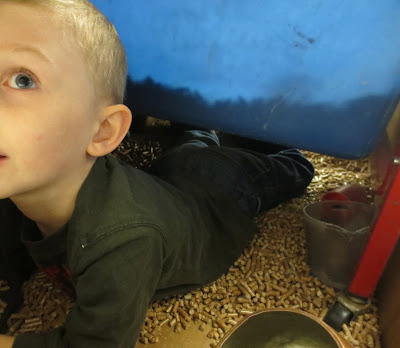I cut quite a few large holes in the box so children would have access to the table and the material in the table.
Since there were so many holes, the children could work inside the box while being outside the box (the child below in the light blue top in the foreground).
There was even room to crawl into the box next to the table. On the far side in the picture above, two children actually climbed into the box. In other words, they played in the embedded table from inside the box in which the table was embedded. And there is no better way to explore space than to inhabit it with your whole body.I thought I knew the spaces I created for this apparatus. As it turned out, the children showed me a space that was completely oblivious to me. Namely, the space under the table that was embedded in box.
They showed me this was a place to explore in two ways. The first was that it was a container just like the table for holding the materials. The second way was that it was a place to physically occupy.
In the picture above, the child has extended her leg under the table so her pink stocking foot is visible under the table.
One child went so far as to crawl underneath table. I am not sure why, but his body was getting to know the "under" space.
When I saw the children exploring this "under-the-table space," I remembered thinking that I should build more apparatus that utilized the space under the table. Even though I made a mental note to use that space in another apparatus, I never did.
Last September, I was reminded again of that the space under the table held possibilities for exploration and play. In one of the sessions I did in Australia last year, one group attempted to make use of that space under the table.
It all started spontaneously with a touch of serendipity. As the group was working on an apparatus to fit in the table, they nonchalantly placed a narrow yellow pipe under the table. They thought they were going to incorporate it into their apparatus they were building inside the table.
One of the participants grabbed a spool and decided to see if she could roll it down the pipe to the other end.
It became a little game between two of the participants to see if they could role the spool on the pipe from end to end under the table. It was not easy, but their "play" was utilizing a space they had just discovered.
In the end, the pipe and the space underneath the table were not included in the final apparatus.
The yellow pipe was still under the table near the end of their building process, but by now it was just one component that could not be incorporated into the apparatus.
I actually got pretty excited watching this group play in that space under the table. It reminded me of the children inhabiting that space so many years ago. It makes not difference that they did not use the space under the table in their final apparatus. What matters was that these adults were truly playing, playing with possibilities. What matters was that they followed a serendipitous tangent that helped them discover the space under the table. What matters was their research odyssey to understand the space and materials with which they worked.











No comments:
Post a Comment